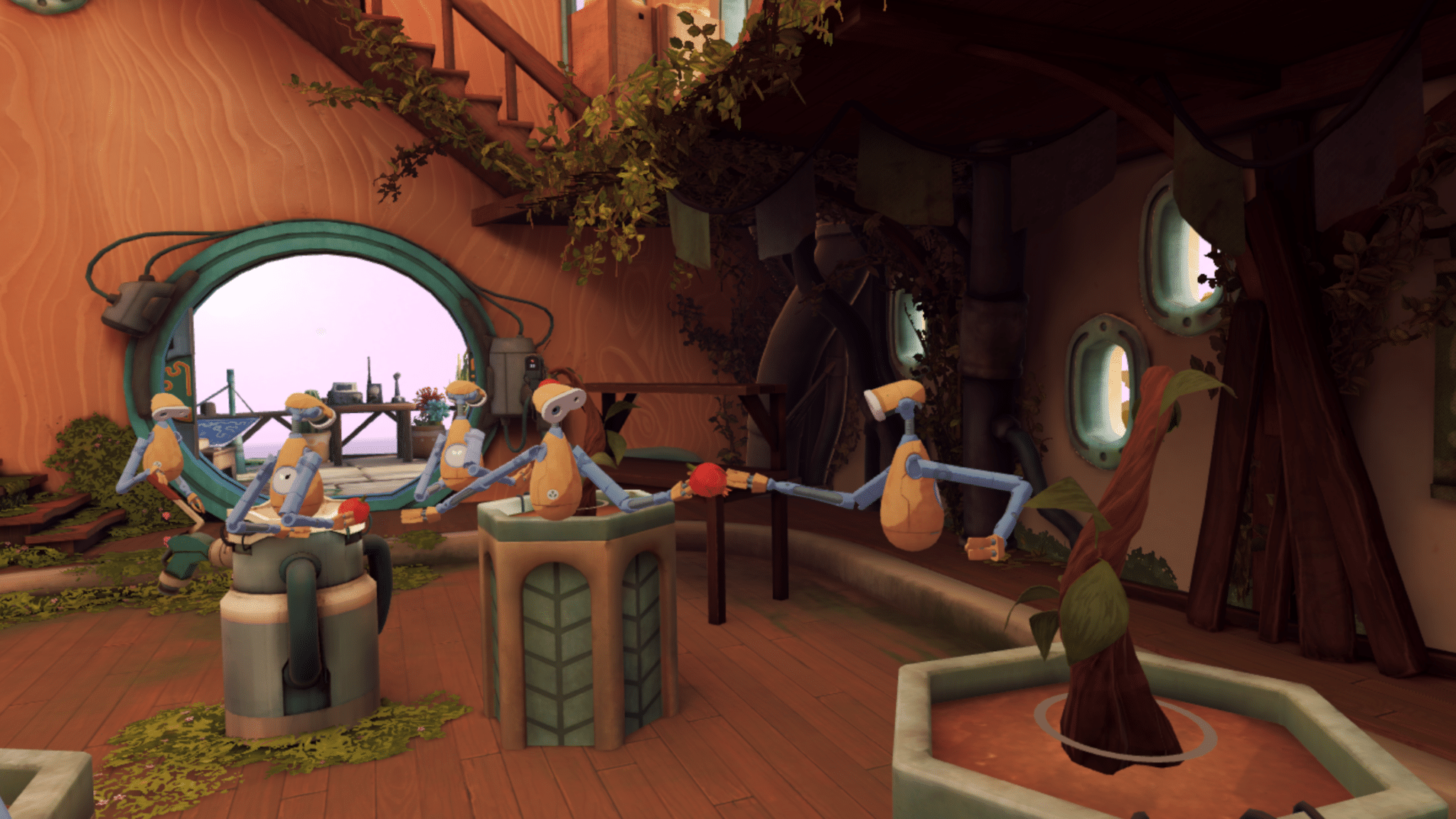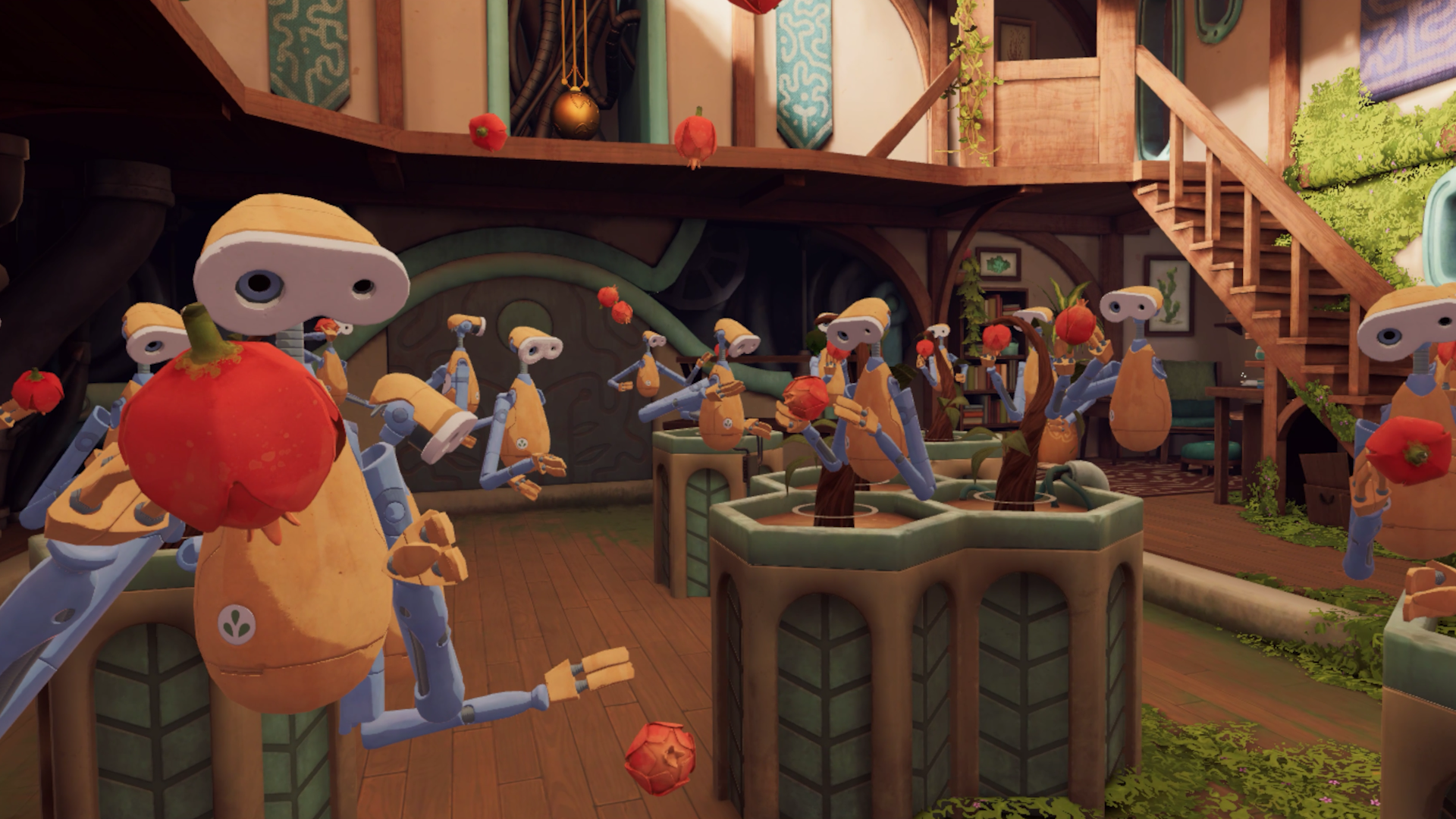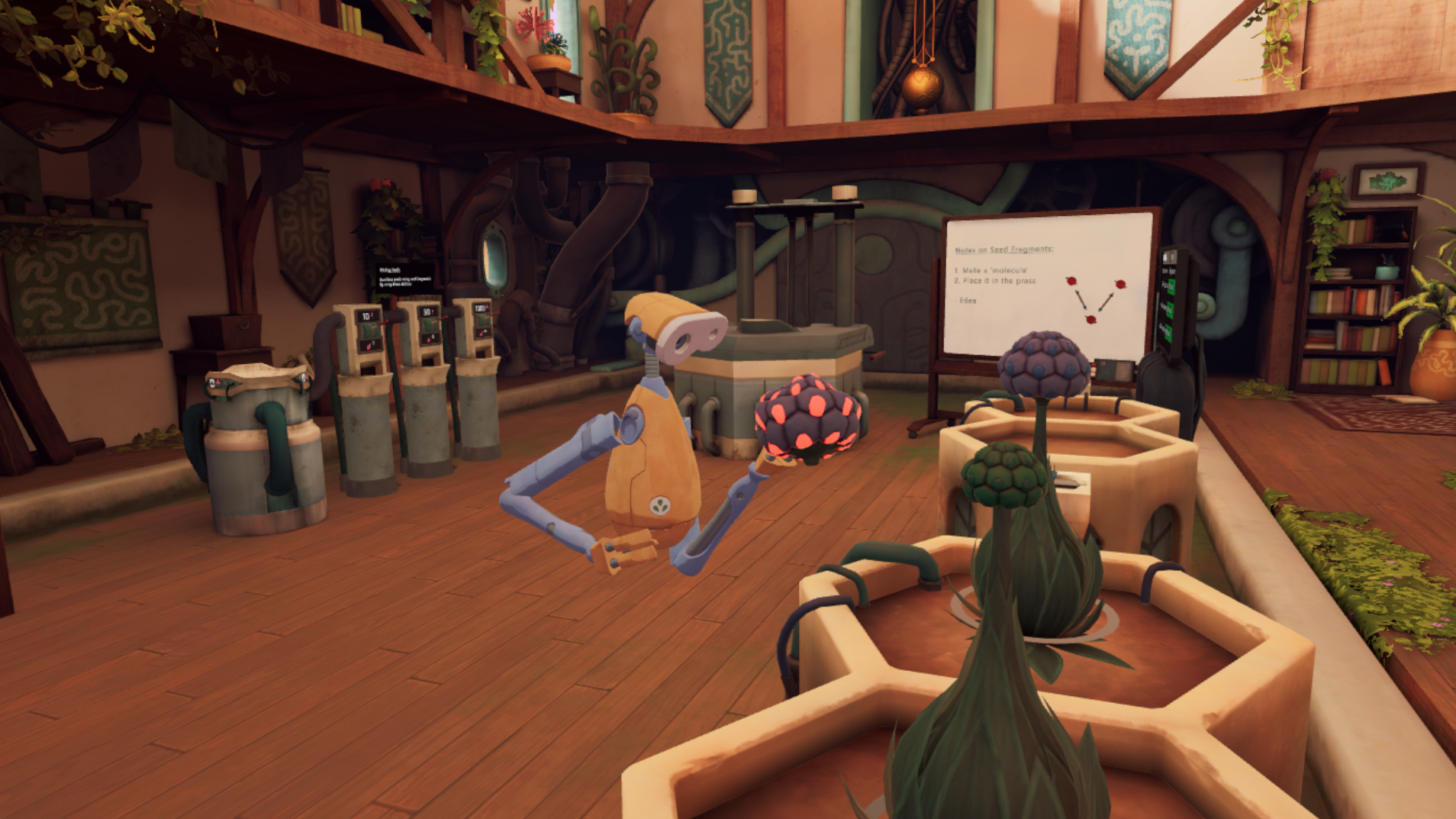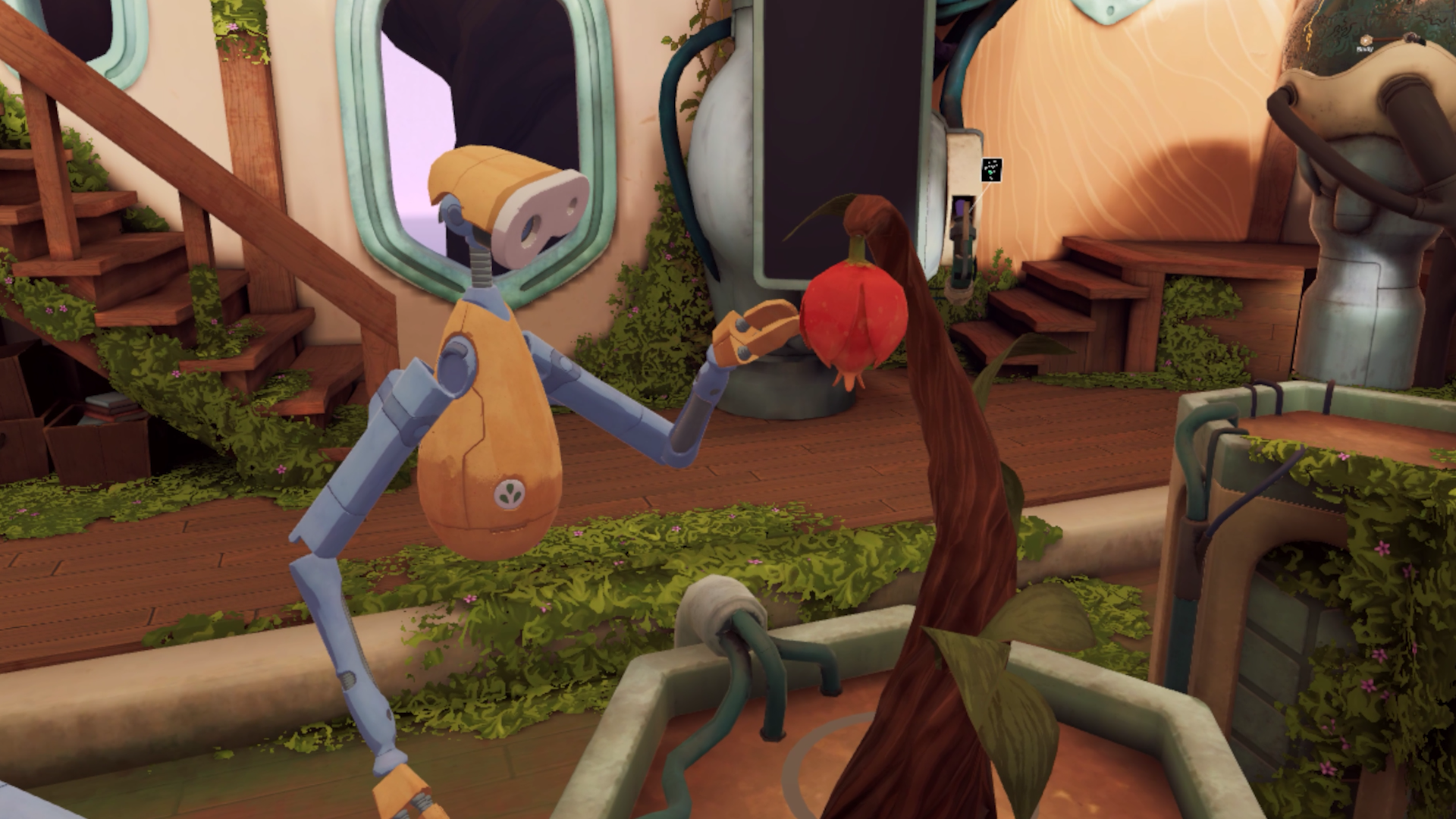The Last Clockwinder lets you program a chain of cloned robots and create automated fruit production lines to solve increasingly complex puzzles. Here’s our The Last Clockwinder review.
I know what you’re thinking — a puzzle game based around factory automation doesn’t sound like the most enthralling way to spend a few hours in VR. But I can assure you that the opposite is true – The Last Clockwinder is a true delight and gem of a puzzle game that’s well worth your time.
The premise is pretty simple — returning to a mechanical, mystical tree after many years away, you’ll need to use programmable clone robots to revive and automate several fruit production lines to both power and prevent it from sinking into the ocean. There’s a pretty basic story peppered throughout the game, delivered through phone calls and voice recordings, but it rightly takes a background role in favour of the main event: automation and optimization puzzles.

Fruit Picking Puzzles
The entire game is essentially set in one large, cozy room within the tree. However, the centre of the room is frequently swapped out, presenting new areas and puzzles that are unlocked gradually throughout the campaign.
The main mechanic at the centre of The Last Clockwinder’s puzzles is your ability to record 1-4 second actions, using your controllers/in-game hands, which will then get repeated over and over, infinitely, by a robot clone. This allows you to build automated production lines where the robots interact with the environment and each other in complicated and dynamic ways to solve puzzles.
It starts out simple. For example, one mission has you picking a piece of fruit from a tree and placing it in a bin at the other side of the room. You might get one robot to pick the fruit, then use five other robots to pass it down the room and into the bin. A simple solution, but not necessarily the most effective – why have five robots slowly pass the fruit when you can use just one robot throw it across the room instead?
You’ll soon be recognising countless opportunities for efficiency at every corner, leading to many empowering ‘a-ha’ moments. The complexity of the production lines quickly ramps up across rooms, adding new requirements, increased production goals and different types of fruit that behave differently. Sticks will allow your robots to attach multiple pieces of fruit together, for example, with some areas requiring specific combinations of fruit to be attached to each other before they get deposited. Other types of fruit possess their own challenges – some require tools to be cut from vines, while others don’t necessarily obey the laws of gravity. The variety in mechanics is smartly-implemented and very welcome.

Open-Ended Optimisation
While technically a puzzle game, The Last Clockwinder is much more about optimization than it is challenging trials. A few moments might leave you puzzled, but the answer is often obvious – the real challenge is in developing a method to get there. The beauty of the game’s open-ended nature is that you’re constantly coming up with solutions that feel completely unique, as if no one else would ever think of completing the puzzle in the same way. I was never once worried if there was a ‘right’ way to finish to any given level. The focus is on creatively playing around until you find something that works, and then rebuilding it in parts or from scratch to optimise it further, if need be.
Whiteboards in each room will advise you on the tiers of efficiency that are possible given the level’s restraints. The lowest tier, for example, might start at using 10 clones or less to produce at least 45 fruit per minute. The next tier might see that go up to 12 clones for 45 fruit per minute, then the final to 15 clones for 120 fruit per minute.
While fun targets, you won’t need to actually meet any of them to progress. New areas are unlocked through total fruit collected, not the rate of production, which means that even the most sub-optimal and slowest solution to any puzzle will eventually unlock the next area, it just might take a while.
This grants the player a lot of flexibility, allowing you to spend as much or as little time as you want perfecting each area. You can also return after you finish the campaign and re-jig your production lines to reach those higher levels of efficiency, adding some replayability.

Beautifully Balanced, Perfectly Polished
The Last Clockwinder’s economic sensibility is backed by strong, reliable interactions and the physics system. There’s extreme precision and predictability to every action, giving you the chance to master sequences and improve from every angle. Even when new mechanics are introduced, nothing ever feels out of your control — it is as tight and balanced as possible.
This became a recurring theme from my time with The Last Clockwinder – balance and polish. Aesthetically, the game is wonderful to look at, especially on Quest 2, and it has near-rock solid performance. That’s impressive given the dynamic and complex nature of some scenes. The campaign may only be four hours long (up to six, depending on your play style) but that feels perfectly apt here. There’s a thoughtful amount of variety across the campaign and the studio has a Nintendo-like knack for pacing the introduction of new mechanics, then gradually adding complication in layers.
This extends to sound. The audio delivery of the narrative never prevents you from performing tasks at the same time, which is perfect. In terms of soundtrack, the piano-focused tracks are absolutely beautiful and perfectly restrained, pairing wonderfully with the whimsical visual presentation. All of these elements come together to produce a Miyazaki-esque charm, providing the perfect tonic against the sometimes-chaotic nature of the puzzle gameplay.

The Last Clockwinder Review – Final Verdict
The Last Clockwinder is a truly balanced experience that feels incredibly accessible despite the potentially daunting nature of the tasks at hand. The technical and optimization-based approach to puzzles is a thoughtful concept that breathes new life into a familiar genre. Even better, it’s wrapped in a stunning, calming and immersive world, giving you just the right amount of story and a serene soundtrack to boot. The game’s gentle guidance, both in tone and gameplay, ensures the puzzles never feel overwhelming, but empowering.
It’s an absolute delight to unravel the mystery of The Last Clockwinder and beyond satisfying to feel such a strong level of creative and intellectual control over the solutions to each puzzle. With no wrong answer to any given problem, it’s a puzzle game that centres itself around letting you choose your own approach at all times. If you’re looking for a relaxing yet stimulating few hours in VR, The Last Clockwinder comes highly recommended.

UploadVR recently changed its review guidelines, and this is one of our new Recommended review labels. You can read more about our review guidelines here.


























